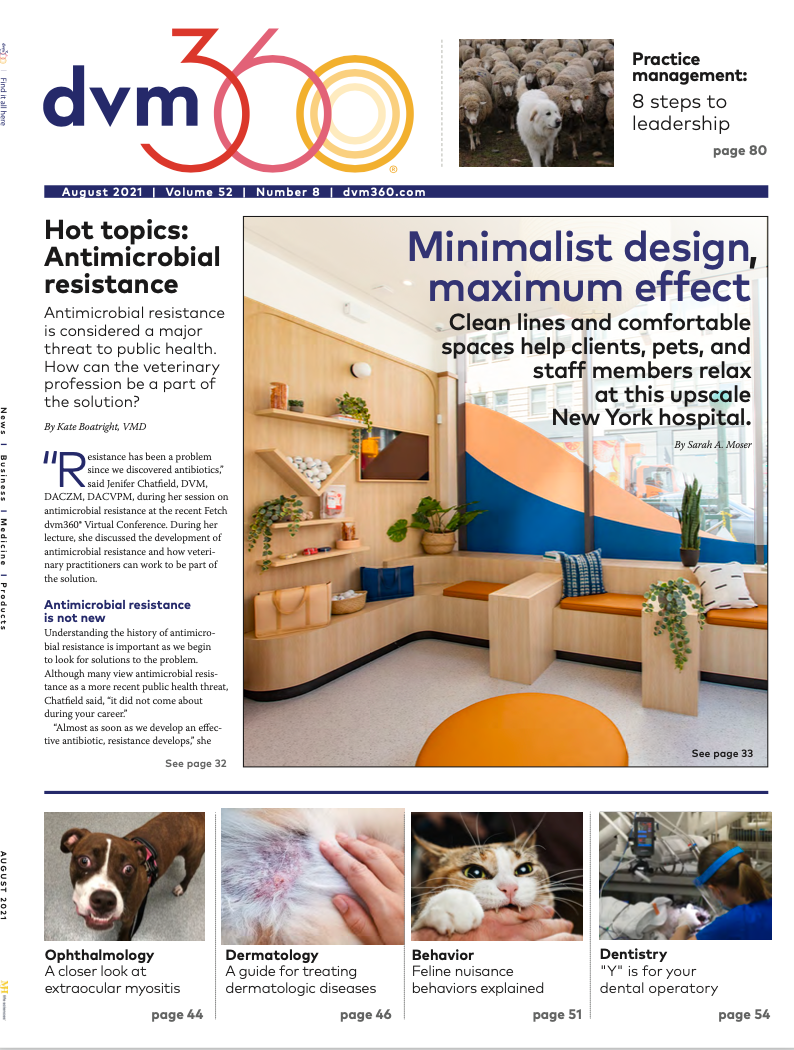Pharmacy relations 101: Common sources of error and prevention strategies, part 2
Serious prescription errors have been reported when pet prescriptions are filled at community pharmacies. Awareness of why these errors might occur and strategies for prevention will help protect patient health and improve working relationships between veterinarians and community pharmacists.
Pharmacists are well-educated professionals who play an important role in the health care team on the human side. However, many pharmacists are not equipped with the veterinary-specific pharmacology training to fill the same role in the animal space. As discussed in our previous article, increasing numbers of veterinary prescriptions are being filled at human pharmacies. This has led to the recognition of many serious errors that have occurred.1 These errors are preventable with improved education of the pharmacy team and pet owners.
Limited awareness of toxic ingredients
Veterinarians are well aware of toxins that may be found in human medications. Not surprisingly, pet owners and pharmacists lack the same level of awareness.2,3 A 2017 study of North Carolina pharmacists found that only 60% of substances (15 out of 25) were correctly identified as toxic or nontoxic.2 This level of awareness was only slightly higher than that of the general pet owner population, which correctly identified 13 of 25 potential toxins (52%) as toxic or nontoxic in a separate survey.3 Twenty-four of the 25 items assessed in both surveys were identical and the one item that differed was nontoxic (tomatoes in the pharmacist survey and molasses in the pet owner survey).
Two toxins that are especially worrisome are xylitol and acetaminophen. Pharmacists were not aware of the toxicity of xylitol, and although many were aware of potential acetaminophen toxicity, they were not familiar with species-specific differences between dogs and cats.2 One strategy to reduce the risk of inclusion of toxic ingredients in medications dispensed to pets is to provide an information sheet to local pharmacists regarding common pet toxins and the species that they affect. The same information could be posted in your clinic to help increase awareness among pet owners of these toxins.
Xylitol, an artificial sweetener, is known to be found in many human medications and food products. Most veterinarians are highly aware of the presence of xylitol in most gabapentin suspensions, but there may be less awareness of its presence in chewable and orally disintegrating tablets. Although awareness of this life-threatening toxin in dogs is growing among pet owners, many may not be aware of its potential presence in medications. Some pet blogs, in an attempt to increase awareness, have covered stories of dogs that have died after receiving medication containing xylitol.
It is essential that veterinarians note on prescriptions for oral suspensions and orally disintegrating or chewable tablets that the product “must not contain xylitol due to toxicity in dogs.” If your clinic uses a computerized prescription template, consider customizing it to include this information on every printed prescription so the information is not inadvertently missed during a busy day.
Acetaminophen or other ingredients like homatropine are often found in combination products with opioids. These ingredients are often added to decrease the diversion potential, and in some cases, such as with codeine, adding acetaminophen brings it from a Schedule II to a Schedule III drug. However, if a veterinarian is scripting out hydrocodone or codeine, they are often looking for the pure opioid product. Dispensing of the combination product would not be a legal substitution but has been reported. By writing “no substitutions” on the script, you can minimize the chances of this happening.
Inappropriate recommendation of OTC medications
Pharmacists can legally recommend OTC medications to human patients for their labeled uses. Because the use of human OTC medications in animals is extralabel drug use, pharmacists should not make recommendations, although this does happen. Recommendation of an OTC nonsteroidal anti-inflammatory drug or acetaminophen for an animal is one of the largest concerns, but other OTC products have the potential to be toxic (ie, antihistamines in combination with a decongestant such as phenylephrine) or contain toxic ingredients (ie, xylitol).
For instance, if a concerned pet owner approaches the pharmacy counter on a Sunday morning when their veterinary office is closed and asks what they can give their small dog, who is limping after jumping off the bed, to keep it comfortable until the vet opens, a well-meaning pharmacist might equate a small dog to a human infant and recommend ibuprofen (Children’s Motrin), unaware of the serious toxicity of this medication.
Because all OTC human medications are extralabel, it is best practice to treat them like prescription medications for your patients. Provide pet owners with a written prescription for any OTC medications. Advise them that the script is to ensure they get the appropriate product. For instance, you may intend for your client to purchase dimenhydrinate when you recommend Dramamine, but there are multiple formulations available. In some, the active ingredient is meclizine. Although this is nontoxic, it won’t necessarily provide the same effects.
Veterinary teams should educate pet owners that OTC medications should never be used without first checking with the veterinarian. Encourage pharmacists to refer all client questions regarding use of OTC medications in their pets to the veterinarian. Introducing yourself to local pharmacists and providing contact information for basic questions can be a helpful step in improving interprofessional relationships.
Insulin and insulin syringes
A specific subset of the dosing and dispensing errors discussed previously is changes to insulin type or mistakes in insulin syringes. There are several types of insulin prescribed for use in pets, both on-label (Vetsulin and ProZinc, U-40) and extralabel (NPH insulin, insulin glargine, and insulin detemir, U-100). Veterinarians carefully select insulin based on the species they are treating, size of the pet, and client financial concerns.
Pharmacists have been known to suggest substitution of a less expensive insulin to help clients with financial concerns. This can result in a poor response to therapy and even lead to a patient progressing into diabetic ketoacidosis.1 Writing “no substitutions” on the script can help to prevent this, but with some insulins being available OTC for humans, it can become difficult to control what insulin a client purchases at the pharmacy.
Because U-40 insulins are only labeled for animal patients, many pharmacists are unaware that this insulin concentration exists. Therefore, when it comes to insulin syringes, many pharmacists are not aware of the difference between U-40 and U-100 syringes.4 The misuse of syringes can result in under- or overdosing of patients. Even if a client is supposed to use U-100 syringes, there are a variety of syringe sizes and needle sizes available at the pharmacy. Not all syringes contain half-unit markings, which can be important for small patients who need very fine dosing adjustments. When writing a prescription for insulin syringes, specify the concentration of the syringe (U-40 or U-100), total volume, and needle parameters (length and gauge).
Client education is an essential part of preventing errors with insulin and syringes. Veterinarians should discuss the cost of insulin with their clients prior to starting treatment to prevent surprises when they arrive at the pharmacy. Clients should be educated on insulin administration, storage and handling, and syringe types before leaving the office. It can be beneficial to show a client both a U-40 and a U-100 insulin syringe and explain the differences and why it’s important that the correct one be used. If a veterinary-specific (U-40) product is being dispensed, teach clients that insulin and syringes should only be purchased through a veterinary office. Finally, encourage clients to bring syringes and insulin products to recheck appointments to verify that they are using the intended product and syringes.
What to do when errors occur
Unfortunately, despite our best efforts, errors do sometimes occur. In these cases, several steps should be taken:
- First, contact the pharmacy to advise them of the problem. Only by making the pharmacy staff aware of the issue can you help to prevent a repeat of the same error.
- Second, report the error to the AVMA, which collects data on pharmacy complaints: https://www.avma.org/sites/default/files/resources/complaint_form.pdf
- Third, report serious errors to the state pharmacy board.
Conclusion
Ultimately, prevention of errors comes down to clear communication with pharmacists and clients. While it may seem time-consuming to have these conversations, the reduction of errors leading to patient compromise, upset clients, and a frustrated veterinary team is invaluable. Leverage your support staff to provide client education during your office visits and make use of written discharge instructions.
We encourage you to take time to build a relationship with local pharmacists and establish yourself as an expert. We are all professionals who want the best possible outcome for our patients and can learn from one another. The time you spend now reaching out to pharmacies will ultimately save the time you would have spent correcting errors in the future.
References
- Kolb G. Veterinary prescriptions & retail pharmacies summary of membership survey. September 2012. Accessed August 22, 2018. https://www.ftc.gov/sites/default/files/documents/public_comments/request-comments-and-announcement-workshop-pet-medications-issues-project-no.p121201-560891-00569/560891-00569-84588.pdf
- Young NW, Royal KD, Davidson GS. Baseline knowledge of potential pet toxins: a survey of pharmacists. Pharm Pract (Granada). 2017;15(4):1058. doi:10.18549/PharmPract.2017.04.1058
- Young N, Royal K, Lovee B, Davidson G. Baseline knowledge of potential pet toxins among the US general public. J Appl Anim Welf Sci. 2019;22(3):219-228. doi:10.1080/10888705.2018.1473158
- Frankel G, Kusno A, Louizos C. Five things every community pharmacist should know when dispensing for 4-legged patients. Can Pharm J (Ott). 2016;149(2):99-106. doi:10.1177/1715163516628543
Kate Boatright, VMD, a 2013 graduate of the University of Pennsylvania, is a practicing veterinarian, freelance speaker, and author in western Pennsylvania. She is passionate about mentorship, education, and addressing common sources of stress for veterinary teams and recent graduates. Outside of clinical practice, she is actively involved in organized veterinary medicine at the local, state, and national levels.
Lauren Forsythe, PharmD, DICVP, a 2015 graduate of the University of Findlay, College of Pharmacy, completed her veterinary pharmacy residency at Purdue’s Veterinary Teaching Hospital. After her residency, she spent 3 years as a veterinary clinical pharmacist at the UC Davis Veterinary Medical Teaching Hospital and is now the medication dispensary coordinator at the University of Illinois Veterinary Teaching Hospital. She is a Diplomat of the International Society of Veterinary Hospital Pharmacists. In addition to her full-time veterinary pharmacy career, she has experience working in a retail pharmacy.

